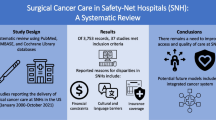Abstract
Background
The National Cancer Strategy heralded a major reorganisation of the delivery of cancer services in Ireland. As a result of this policy, cancer care was centralised to eight centres. The impact of this strategy on hospitals no longer providing cancer services has not been analysed to date.
Aim
The aim of this study was to examine the impact of centralisation of cancer services on surgical workload at Mayo General Hospital.
Methods
Data pertaining to all surgical procedures performed in 2007 (prior to the introduction of the National Cancer Strategy) and 2011 were obtained using the Hospital Inpatient Enquiry system. Histopathology reports and theatre registers were also analysed to ensure accuracy of the data.
Results
The numbers of elective and emergency surgical admissions during 2007 and 2011 were broadly similar (2,581 vs. 2,662). One hundred and thirty-five oncological procedures (colorectal and breast) were carried out in 2007 compared with 50 (colorectal) in 2011. This represents a 63 % reduction in cancer surgery workload following the implementation of the National Cancer Strategy. There was a concomitant increase in surgery performed for benign conditions (laparoscopic cholecystectomy and hernia repair), which coincided with the innovative introduction of 43 ring-fenced surgical in-patient beds in June 2010.
Conclusion
This study demonstrates the impact of the centralisation of cancer services on surgical workload in a non-cancer centre. Our results show that there continues to be a role for general hospitals in the provision of elective surgical services. Hospital network arrangements have the potential to facilitate such developments.


Similar content being viewed by others
References
A strategy for cancer control in Ireland. National Cancer Forum 2006. Available at http://www.hse.ie/eng/services/Publications/HealthProtection/Public_Health_/National_Cancer_Control_Strategy.pdf. Last accessed 9/10/12
Archampong D, Borowski D, Wille-Jørgensen P, Iversen LH (2012) Workload and surgeon′ s specialty for outcome after colorectal cancer surgery. Cochrane Database of Syst Rev, Issue 3, Art No: CD005391. DOI:10.1002/14651858.CD005391.pub3
Halm EA, Lee C, Chassin MR (2002) Is volume related to outcome in health care? a systematic review and methodological critique of the literature. Ann Intern Med 137(6):511–520
Woo YL, Kyrgiou M, Bryant A, Everett T, Dickinson HO (2012) Centralisation of services for gynaecological cancer. Cochrane Database of Syst Rev, Issue 3, Art No: CD007945, DOI:10.1002/14651858.CD007945.pub2
Comber H, Walsh PM. Patterns of Care and Survival from Cancer in Ireland 1994–2004. Summary Report. National Cancer Registry Ireland. Available at: http://www.ncri.ie/pubs/pubfiles/Patternsofcareandsurvival_1994to2004_summary.pdf. Last accessed 9/10/12
Concannon ES, Hogan AM, Flood L, Khan W, Waldron R, Barry K (2012) Day of surgery admission for the elective surgical in-patient: successful implementation of the Elective Surgery Programme. Ir J Med Sci, pp1–7. DOI:10.1007/s11845-012-0850-5
Coyle D, Lowery A, Khan W, Waldron R, Barry K (2012) Successful introduction of ring-fenced inpatient surgical beds in a general hospital setting. Ir Med J 105(8):6
Piggott R, Hogan A, Concannon E, Khan W, Waldron R, Barry K (2012) Positive impact of ‘ring-fencing’ on surgical site infection rates in general surgical practice; a comparative study. Freyer Symposium Abstract. Ir J Med Sci 181 (Suppl 6):S180. DOI:10.1007/s11845-012-0839-0R
Mc Intyre P (2004) Ireland’s bumpy road to a world-class cancer service. Cancer World 54–58
Mayer EK, Bottle A, Darzi AW, Athanasiou T, Vale JA (2010) The volume-mortality relation for radical cystectomy in England: retrospective analysis of hospital episode statistics. BMJ 340:c1128
Purushotham AD, Pain SJ, Miles D et al (2001) Variations in treatment and survival in breast cancer. Lancet Oncol 2:719–725
Kesson EM, Allardice GM, George WD, Burns HJG (2012) Effects of multidisciplinary team working on breast cancer survival: retrospective comparative, interventional cohort study of 13 722 women. BMJ 344 Doi:http://dx.doi.org/10.1136/bmj.e2718
Ke KM, Hollingworth W, Ness AR (2012) The costs of centralisation: a systematic review of the economic impact of the centralisation of cancer services. Eur J Cancer Care 21:158–168
Baird AG, Donnelly CM, Miscampell NT, Wemyss HD (2000) Centralisation of cancer services in rural areas has disadvantages. BMJ 320 (Letters): 717
Acknowledgments
Tthere is no source of funding to be declared.
Conflict of interest
The authors of this study have no competing interests.
Author information
Authors and Affiliations
Corresponding author
Rights and permissions
About this article
Cite this article
Concannon, E., Robertson, I., Bennani, F. et al. Life after the cancer strategy: analysis of surgical workload in the general hospital setting. Ir J Med Sci 182, 433–438 (2013). https://doi.org/10.1007/s11845-013-0906-1
Received:
Accepted:
Published:
Issue Date:
DOI: https://doi.org/10.1007/s11845-013-0906-1




